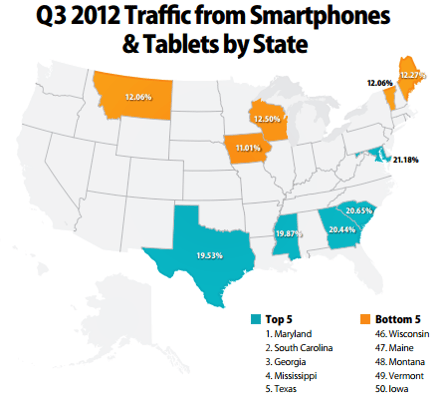The Mobile Impact; Stats, States, & Data

Mobile traffic is valuable traffic.
In fact, a recent Monetate study reveals that nearly one out of every five consumers has made an online purchase with a mobile device. Furthermore, over the last year, tablet shopping traffic increased 161 percent while smartphone traffic increased 119 percent.
However, only merchants and marketers who have a strong mobile presence are reaping these benefits. Luckily, Monetate's Ecommerce Quarterly study contains a plethora of mobile shopping insights, which Web workers can use to better improve their mobile-optimized websites and marketing strategies.
The Stats
Some of the most intriguing metrics from the study show that even though traditional desktop traffic still makes up 81.6 percent of the market share, these shoppers actually have the lowest average order value (AOV) at $91.76. Conversely, tablet shoppers only make up 8.37 percent of the website traffic market share, yet have a higher AOV of $96.84, while smartphone shoppers make up 10.03 percent of traffic and have the highest AOV of $97.82.

This data proves that even though desktops still drive the most traffic, mobile customers tend to spend more when they actually make a purchase. Yet, it is important to note that smartphone shoppers have the lowest conversion rate at 1.01 percent followed by tablets at 3.12 percent, while traditional desktop traffic has the highest conversion rate of 3.28 percent.

In order to get the best return on investment (ROI) from mobile, merchants shouldn't only create a mobile-optimized site, but instead build smartphone and tablet specific sites. This is because Monetate's statistics show that tablet shoppers are much more likely to convert than smartphone shoppers, despite the fact that smartphones drive more traffic. This is most likely the result of consumers who leverage their smartphones to comparison shop while inside brick-and-mortar stores. For this reason, merchants should create smartphone sites that prominently display product ratings and reviews, and tablet sites that feature easy-to-use navigational elements and high-quality product images.
The States
While it is clear that mobile is worth the investment, there are still many uncertainties when it comes to mobile marketing. That being said, marketers should be aware of the geographic locations that contain the highest number of mobile savvy shoppers. According to Monetate's report, Maryland drives the most mobile traffic, followed by South Carolina, Georgia, Mississippi and Texas.

By leveraging this geographical data, marketers can build mobile campaigns that target shoppers in these states. For example, marketers can create location-specific campaigns that include incentives to buy, as well as display geotargeted customer testimonials to consumers in a specific area. Additionally, marketers can combine geotargeted messages with in-store inventory data, which can help drive sales both in-stores and online. For instance, marketers can promote in-store returns for online shoppers or launch a geotargeted banner that features an item that is out-of-stock online, but is available at a nearby store.
Your Data
While all of the aforementioned data can be used as a good starting point for optimizing mobile sites and marketing campaigns, merchants and marketers should rely on their own analytics for optimizing their mobile strategies. For example, even though Maryland is overall the top state for mobile traffic, your analytics may reveal that your business receives most of its mobile traffic from Wyoming or Hawaii, which would make it a better idea for your campaigns to center around those areas.
At the end of the day, it is important to remember that mobile is still an emerging channel, so testing a variety of elements and analyzing the results (for mobile sites and marketing campaigns), is the only way to ensure that you're receiving the best ROI for your company's mobile initiatives.

Subscribe to Our Newsletter!
Latest in Mobile Marketing










